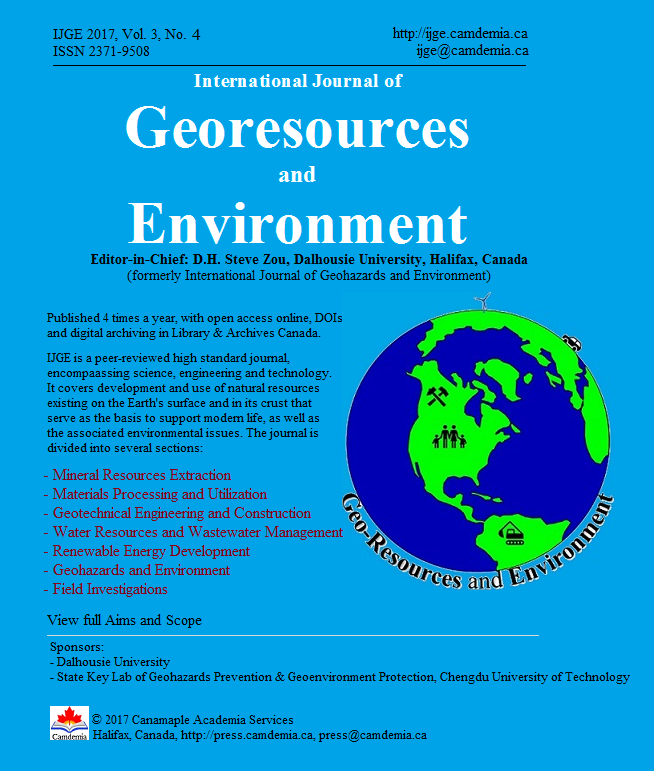Optimal Conditions for Treating Acid Mine Drainage using Bentonite-Steel Slag Composites
DOI:
https://doi.org/10.15273/ijge.2017.04.014Keywords:
Acid Mine Drainage, heavy metal ions, bentonite-steel slag composite particles, adsorb, precipitate, influencing factors, technologic conditionsAbstract
Acid mine drainage is characterised by low pH and high concentrations of heavy metal ions, such as Fe2+, Mn2+, Cu2+ and Zn2+. In this paper, composite particles consisting of bentonite and steel slags are used to dispose acid mine drainage. Bentonite is an mineral material which has an excellent capacity to adsorb heavy metal ions. Steel slags are alkaline, an industrial solid waste commonly used in the treatment of acid mine drainage. The main influencing factors, including adsorbent dosages, shaking rates, concentrations of heavy metal ions, temperature, adsorption time and pH value are examined using a static experiment. The results indicate that the removal efficiency of heavy metal ions improves when increasing the adsorbent dosages and the concentrations of the heavy metal ions, speeding up the shaking rates, raising temperature, extending the adsorption time and increasing pH value. With a consideration of removal efficiencies combining with treatment costs, the optimum reaction conditions for the four types of heavy metal ions are obtained, which are an adsorbent dosage of 21 mg/L, a rotational speed of 120 r/min, temperature 25’„ƒ, adsorption time 100 min and initial wastewater pH7. The highest initial concentration of Fe2+, Mn2+, Cu2+ and Zn2+ was 150 mg/L, 100 mg/L, 170 mg/L and 140 mg/L, respectively, and the removal rates was 93.42%, 92.64%, 93.86% and 95.17%, respectively, when the four heavy metal ions existed independently in the simulated mine wastewater. The determination of the particles‘ SEM-EDS Microscopic characterization show that the composite particles play a partial role in neutralizing, absorbing and the chemical precipitation. The acidity decreased notably and the heavy metal ions of Fe2+, Mn2+, Cu2+ and Zn2+ were adsorbed and precipitated effectively. The research results can extend the practical engineering application of the composite particles.Downloads
Issue
Section
License
Copyright, Terms and Conditions
The International Journal of Geohazards and Environment (the Journal) is published by Canamaple Academia Services (the Publisher) online with open access, under a Creative Commons Attribution-Noncommercial license (CC-BY-NC) (http://creativecommons.org/licenses/by-nc/4.0/). Authors (the Authors) submitting papers (the Work) for publication in the Journal automatically agree to the following terms and conditions.
1. Under the license (CC-BY-NC), Authors give permission for others to share and reuse the Work, as long as the original source and author(s) are properly cited (i.e. a complete bibliographic citation and link to the Journal website) and the material is not used for commercial purposes. Any sharing or reuse must however indicate the original CC-BY-NC license terms of the work.
2. Authors transfer and assign to the Publisher all copyright in and to the Work. However Authors retain all proprietary rights except the copyright, related to the Work and also retain the rights a) to use, reproduce, distribute, and publicly display the Work in any medium in connection with the Authors‘ academic and professional activities, such as teaching, presentations and lectures, b) to create derivative works from the Work and to make full use of the Work in future research and publications, c) to authorize others to make any non-commercial use of the Work, d) to make both the pre-published and final-published versions available online in institutional and/or disciplinary repositories or on their own websites with a citation and link to the original paper published in the Journal.
3. Authors warrant that the Work is their original work, it is not copied from anywhere or anyone else, they are totally responsible for the authenticity, originality, validity and accuracy, and the facts and views are their own, that the Work contains no matter which is defamatory or infringes any literary or proprietary rights, intellectual property rights, or any rights of privacy, and that the Work has not been simultaneously submitted to any other journals or publishers. Authors further agree that their manuscripts whether accepted or rejected will not be returned and the rejected manuscripts will be disposed at the journal editor's discretion.
Disclaimer: The Publisher, the Journal and the editors accept no responsibility for statements or opinions expressed by authors. Use of information and materials in the Journal is the sole responsibility of users.


